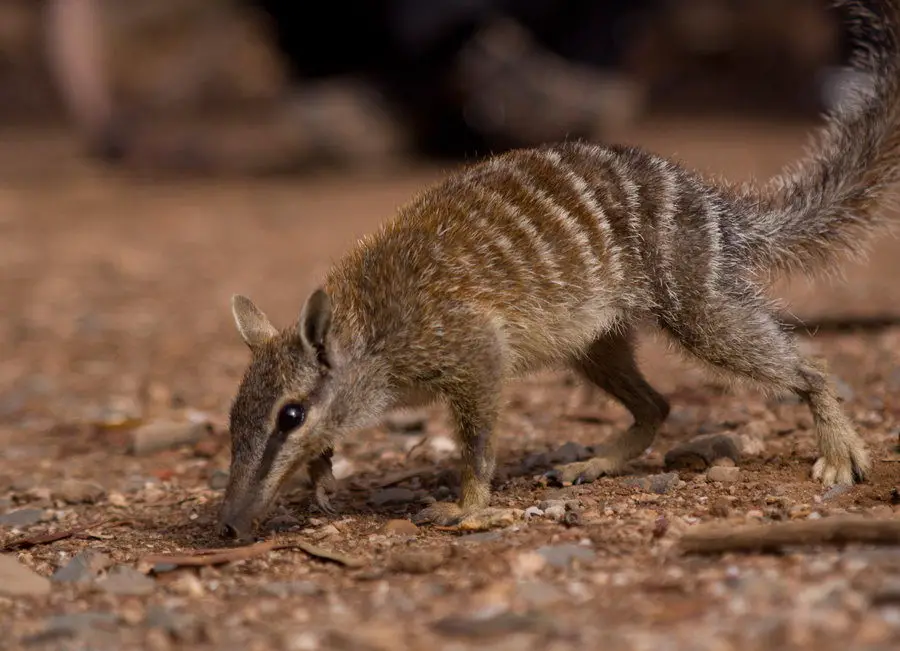The numbat (Myrmecobiidae) is a specialized termite-eating animal that is typically found in the extreme southwestern Australia towards the southern half of Australia. Numbats are admired for their striking appearance which is rarely found among other Australian mammals. The evolutionary history of numbat is quite poorly known.
Numbat Facts
Anatomy
- Numbats are recognized by their beautiful reddish brown coat—the coat that is covered by five to six white stripes across the back. The length of the animal measures around 7.9–10.8 in (200–274 mm). Numbats weigh up to 0.3–0.7 kg (0.66–1.5 lb).
- One of the rare features of numbat is its long tail which is almost the size of the entire body length. The ears are erect and quite narrow.
- The male and female are of the same size.
- The numbat is able to stretch its long thin tongue several centimeters beyond the end of the snout when feeding.
Distribution
Numbats were once widespread all over the southern half of central and Western Australia including western New South Wales and southwestern Northern Territory. However excessive killings of numbats (in 1985) made them disappeared from much of these ranges and at present numbats occur only in the southwest of Western Australia.

Habitat
- Where there are termites there are numbats. Numbats are likely to survive in habitats which offer abundance of termites. They make homes in dense vegetation or hollow logs which provides them enough cover from potential predators.
- Apart from the birds of prey, foxes are now predating numbats in large numbers.
- Numbats used to live in many different habitats ranging from woodland to hammock grasslands to open forest. Currently they occur in areas dominated by eucalypt forests and in terrain covered with sand dunes.
Behavior
- Numbats are entirely diurnal (come out in daylight) probably because termites are their primary food and these insects are likely to be found during the day.
- During the hot time of the day numbats become active but they mostly avoid the hottest part of summer. The numbat continues to find food from midmorning until late afternoon.
- After daylight hours, the numbat becomes inactive in hollow logs or trees and it sleeps in underground burrows.
- They make nests in den which (nests) are lined with grass or shredded bark. Numbats often use more than one den.
- The numbat is a solitary animal prefers to spend time alone except when mothers are rearing young.
- Numbats are highly territorial and their home range is 1.5 square km (370 acres).
- The young numbats become independent in December and they run at a speed of 9 miles (15 km).
Feeding Ecology and Diet
- Numbats are medium-sized animals with a specialized diet of termites. They also consume other insects but termites make up most of their diet. They are known to consume up to 20,000 termites each day.
- They use scent and long sticky tongue to reach out termite galleries. Numbats are adapted to digging small holes which expose termites; they also turn over branches and sticks to consume termites. The saliva on the numbat’s tongue makes it possible to stick as much termites as possible.
- The numbat has extremely sharp claws which they use to dig holes because their forelimbs are very strong.
Reproductive Biology
- There seems to be no fixed months for numbats’ breeding but the young are mostly born in summer. Generally the female gives birth to one young each year
- The gestation period lasts 14 days.
- The young numbats are 2 cm (0.79 in) long at birth.
- The mother feeds her young for 3 months until late October. The young remains with their mother during this time and learn to find out prey.
Conservation Status
Vulnerable
References
Friend, J. A. “Myrmecobiidae.” In Fauna of Australia. Canberra: Australian Government Publishing Service, 1989.
Strahan, R. The Mammals of Australia. Sydney: Australian Museum, Reed Books, 1995.






Leave a Reply